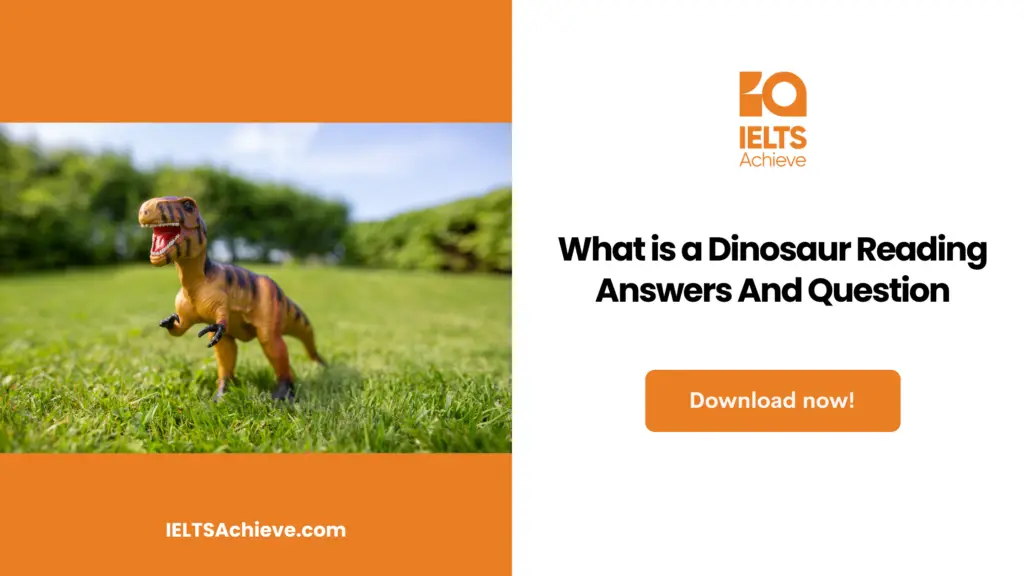The Blog post contains the following IELTS Reading Questions:
- IELTS Reading Sentence Completion
- IELTS Reading Matching Features
- IELTS Reading Matching Headings
Stay informed and prepared for success – Explore our comprehensive Reading Test Info page to get valuable insights, exam format details, and expert tips for mastering the IELTS Reading section.
IELTS Reading Passage: What is a Dinosaur

What is a Dinosaur
A. Even if the name dinosaur is derived from the Greek for “terrible lizard”, dinosaurs were not, actually, lizards at all. Like lizards, dinosaurs are included in the class Reptilia or reptiles, one of the five main categories of vertebrates, animals with backbones. But, at the next level of categorization, within reptiles, noteworthy differences in the skeletal anatomy of lizards and dinosaurs have led analysts to place these classes of animals into two different superorders: Lepidosauria, or lepidosaurs, and Archosauria, or archosaurs.
B. Sorted as lepidosaurs are lizards and snakes and their primordial forebears. Included among the archosaurs, or “ruling reptiles’ ‘, are primordial and modern crocodiles, and the now abolished thecodonts, pterosaurs and dinosaurs. Pre Historians believe that both dinosaurs and crocodiles evolved, in the later years of the Triassic period(c.248-208 million years ago), from creatures called pseudosuchia thecodonts (crocodilian-line archosaurs). Lizards, snakes and different kinds of thecodont are believed to have evolved earlier in the Triassic period from reptiles called Eosuchians.
C. The primary skeletal variance between dinosaurs and other archosaurs are in the bones of the skull, pelvis and limbs. Dinosaur skulls are found in a great variety of shapes and sizes, reflecting the different eating habits and lifestyles of a large diverse group of animals that dominated life on Earth for an remarkable 165 million years. But,different from the skulls of any other known animals, the skulls of dinosaurs had two long bones called vomers. These bones expanded on either side of the head, from the front of the muzzle to the level of the holes on the skull called the antorbital fenestra, located in front of the dinosaur’s orbits or eye sockets.
D. All dinosaurs, even if large or small, four-footed or two-footed, fleet-footed or slow-moving, shared an ordinary body plan. Spotting of this plan makes it feasible to evolve dinosaurs from any other kinds of animal, even other archosaurs. Most notably, in dinosaurs, the pelvis and femur had evolved so that the hind limbs were held upright below the body, rather than splaying out to the sides like the limbs of a lizard. The femoris of a dinosaur had a sharply in-turned neck and a rounded head, which was inserted into a fully open socket or hip socket. A pseudodefect of acetabular cartilage crest helped avert disruption of the femoris. The position of the knee joint, lined up beneath the socket, made it feasible for the whole hind limb to sway backwards and forwards. This distinctive amalgam of characteristics gave dinosaurs what is called a “fully improved gait”. Progress of this highly organized method of walking also evolved in mammals, but amid reptiles it happened only in dinosaurs.
E. For the motive to further categorization, dinosaurs are split into orders:Saurischia(reptile-hipped), or saurischian dinosaurs, and Ornithischia(bird-hipped), or ornithischian dinosaurs. This separation is made on the basis of their pelvic anatomy. All dinosaurs had a pelvic girdle with each side calm of three bones: the pubis(pelvic bone), ilium(iliac bone) and ischium(V-shaped bone). But , the inclination of these bones follows one of two designs. In saurischian dinosaurs, as well as known as lizard-hipped dinosaurs, the pubis(pelvic bone)points forwards, as is normal in lost types of reptile. By difference, in ornithischian, or bird-hipped, dinosaurs, the pubis points backward towards the rear of the animal, which is as well as true of birds.
F. Of the sequence of dinosaurs, the Saurischia was the biggest and the first to evolve. It is split into two suborders: Theropod, or theropods, and Sauropodomorpha, or sauropodomorphs. The theropods, or “beast feet”, were two-footed, predacious carnivores. They varied in size from the mighty Tyrannosaurus rex, 12m long, 5.6m tall and weighing an assessed 6.4 tonnes, to the smallest called dinosaur, Compsognathus, a mere 1.4m long and assessed 3kg in weight when fully grown. The sauropodomorphs, or “lizard feet forms”, included both two footed and four-footed dinosaurs. Some sauropodomorphs were carnivorous or omnivorous but later types were usually herbivorous. They included some of the biggest and best-known of all dinosaurs, such as Diplodocus, a huge four-footed with an elephant-like body, a long, bong tail and neck that gave it a total length of 27m, and a tiny head.
G. Bird- hipped dinosaurs were two-footed or four-footed herbivores, they are now normally divided into three suborders: Ornithopoda, Thyreophora and Marginocephalia. The Ornithopoda, or “bird feet ”, both large and small, could walk or run on their long back legs, poising their body by holding their tails stiffly off the ground back of them. An instance is iguanodon up to 9m long, 5m tall and weighing 4.5 tonnes. The thyreophora, or “shield bearers”, also known as armored dinosaurs, were four-footed with rows of preservative bony prongs, studs or plates along their backs and tails. They contained stegosaurus (stegosaurus longispinus), 9m long and weighing 2 tonnes.
H. The marginocephalians, or “margined heads”, were two-footed or four-footed bird-hipped with a deep thin ruffle or narrow shelf at the back of the skull. An instance is a three-horned dinosaur, rhinoceros-like dinosaur, 9m long, weighing 5.4 tonnes and possessing a prominent neck ruffle and three large horns.
Unlock your full potential in the IELTS Reading section – Visit our IELTS Reading Practice Question Answer page now!
Recommended Questions:
Renewable Energy IELTS Reading Question with Answer
IELTS Reading Questions: what is a dinosaur
Questions 1-7
- Reading Passage has 8 paragraphs (A-H).
- Choose the most suitable heading for each paragraph from the List of headings below.
- Write the appropriate numbers (i-xiii) in Boxes 1-7 on your answer sheet.
- One of the headings has been done for you as an example.
- NB. There are more headings than paragraphs, so you will not use all of them.
1 Paragraph A
2 Paragraph B
3 Paragraph C
4 Paragraph D
5 Paragraph E
6 Paragraph F
7 Paragraph G
Example: Paragraph H
Answer: x
List of headings
i. 165 million years
ii. The body plan of archosaurs
iii. Dinosaurs – terrible lizards
iv. Classification according to pelvic anatomy
v. The suborders of Saurischia
Vi. Lizards and dinosaurs – two distinct superorders
vii. Unique body plan helps identify dinosaurs from other animals
viii. Herbivore dinosaurs
ix. Lepidosaurs
x. Frills and shelves
xi. The origins of dinosaurs and lizards
xii. Bird-hipped dinosaurs
xiii. Skull bones distinguish dinosaurs from other archosaurs
Ready to conquer Matching Headings questions? Click here to learn essential tips and techniques for matching headings accurately to paragraphs or sections in the IELTS Reading section.
Questions 8-10
- Complete the sentences below.
- Use NO MORE THAN THREE WORDS from the passage for each blank space.
- Write your answers in boxes 8-10 on your answer sheet.
8. Lizards and dinosaurs are classified into two different superorders because of the difference in their
9. In the Triassic Period, evolved into the codonts, for example, lizards and snakes.
10. Dinosaur skulls differed from those of any other known animals because of the presence of vomers:
Enhance your sentence completion skills in the IELTS Reading section. Click here to access our comprehensive guide and learn effective strategies for filling in missing words or phrases in sentences.
Questions 11-14
Choose one phrase (A-H) from the List of features to match with the Dinosaurs listed below. Write the appropriate letters (A-H) in boxes 11-14 on your answer sheet. The information in the completed sentences should be an accurate summary of the points made by the writer. NB. There are more phrases (A-H) than sentences, so you will not need to use them all. You may use each phrase once only.Dinosaurs
11. Dinosaurs differed from lizards, because
12. Saurischian and ornithischian dinosaurs
13. Unlike theropods, sauropodomorphs
14. Some dinosaurs used their tails to balance, others
List of features
A are both divided into two orders.
B the former had a “fully improved gait”.
C were not usually very heavy.
D could walk or run on their back legs.
E their hind limbs sprawled out to the side.
F walked or ran on four legs, rather than two.
G both had a pelvic girdle comprising six bones.
H did not always eat meat.
Improve your performance in Matching Features questions by clicking here to access our comprehensive guide. Learn how to match specific features or characteristics with the options provided in the IELTS Reading section.
Unlock your full potential in the IELTS Reading section – Visit our IELTS Reading Practice Question Answer page now!
Recommended Questions:
Renewable Energy IELTS Reading Question with Answer
What is a dinosaur Reading Answers
1. vi
2. Xi
3. xiii
4. Vii
5. iv
6. v
7. Viii
8. Skeletal anatomy
9. Eosuchians
10. Two long bones
11. B
12. G
13. H
14. F

We hope you found this post useful in helping you to study for the IELTS Test. If you have any questions please let us know in the comments below or on the Facebook page.
The best way to keep up to date with posts like this is to like us on Facebook, then follow us on Instagram and Pinterest. If you need help preparing for the IELTS Test, join the IELTS Achieve Academy and see how we can assist you to achieve your desired band score. We offer an essay correction service, mock exams and online courses.

